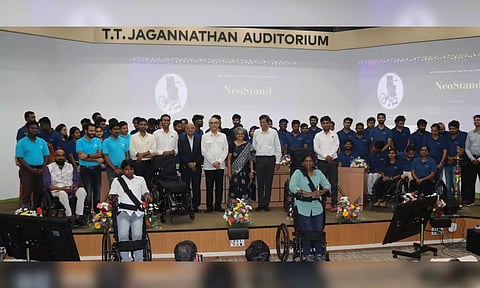

CHENNAI: Indian Institute of Technology (IIT) Madras has developed a customizable Electric Standing Wheelchair, for the benefit of wheelchair users.
The ‘NeoStand’ was launched on March 20 in the presence of Prof. V. Kamakoti, Director, IIT Madras, dignitaries, supporters of this project, faculty, researchers and users of these rehabilitative devices.
NeoStand is a compact standing wheelchair with easy-to-use navigation for its motorized standing mechanism.
At the touch of a button, wheelchair users can effortlessly transition from sitting to standing, opening a world of possibilities—be it engaging in eye-level conversations, reaching for a book, or simply enjoying a cup of coffee standing by a counter.
The project development was led by Prof. Sujatha Srinivasan, Head, TTK Center for Rehabilitation Research and Device Development (R2D2), IIT Madras, who also led the development of ‘Arise,’ India’s first manual standing wheelchair, and NeoBolt, the country’s first motorized add-on for wheelchairs. This device has been commercialized and is being taken to the market through NeoMotion, an IIT Madras-incubated start-up.
Addressing the launch event, Prof. V. Kamakoti, Director, IIT Madras, said, “These are very important translational research works guided by faculty of IIT Madras that have great social impact.”
NeoStand redefines the wheelchair experience with its user-centric design. It promises users the freedom to sit for prolonged hours and stand comfortably when needed reducing the risk of secondary health complications. Its compactness ensures easy manoeuvrability through tight spaces, enhancing accessibility.
The seamless transition between sitting and standing, with an option to pause midway, underscores its innovative approach to improving users’ quality of life and social participation.
Highlighting the benefits of this innovation, Dr. Henry Prakash, Associate Medical Superintendent, Christian Medical College, Vellore and Professor, Department of Physical Medicine and Rehabilitation, Christian Medical College, Vellore, said, “Today as we navigate the complexities of accessibility, affordability, and societal attitudes, let us keep in mind that the advancements in this field of assistive technology is not a technological imperative, but a moral one too.”
For the majority of wheelchair users across the globe, the ability to stand is far-fetched. Standing is essential for better blood circulation, and digestion, preventing health issues like pressure sores and crucial for daily activities. Currently, users are often dependent on external help and some need to use orthoses. For persons with severe disabilities who have compromised upper body strength, this is a significant challenge, and a manual standing wheelchair is inadequate.
The team at IIT Madras set out to tackle this challenge faced by wheelchair users - the necessity and difficulty of standing. The team was committed to providing users with yet another device aimed at enhancing their independence and health.
Highlighting the vision behind this project, Prof. Sujatha Srinivasan, who is also a faculty in the Department of Mechanical Engineering, IIT Madras, said, “Integrating standing function in a wheelchair provides health benefits as well as functional and psychological benefits to the user. Our first standing wheelchair was Arise, a low-cost mechanical design, especially designed for rural users, enabling standing and outdoor mobility for short distances.”
Prof. Sujatha Srinivasan added, “But we had other interested users who did not have the upper limb strength to operate the standing mechanism. With NeoStand, the user just needs to use a switch to move from sitting to standing. Even a caregiver or a therapist in a hospital can help the user practise standing in a gradual manner since NeoStand allows the user to stop at intermediate positions, which is important from a therapeutic standpoint.”
Mr. Justin Jesudas, a person with quadriplegia for the last 14 years, said, “Wheelchairs enable us and it is a safe space for our personal mobility and to perform daily activities. The ability to stand with just a push of a button makes the wheelchair even more inclusive, helping quadriplegics to stand independently.”